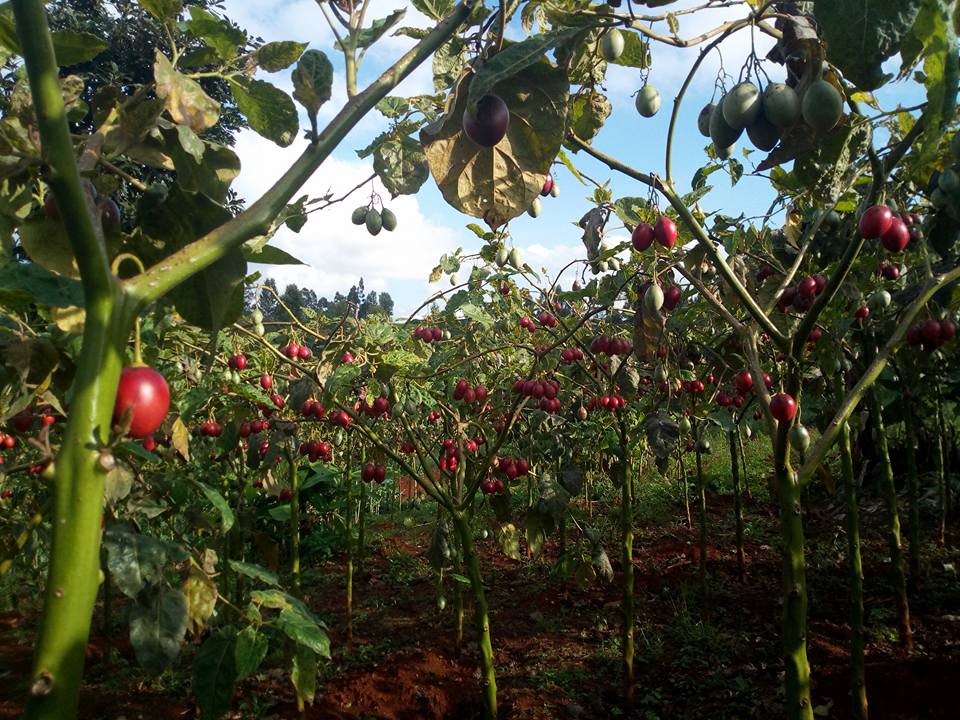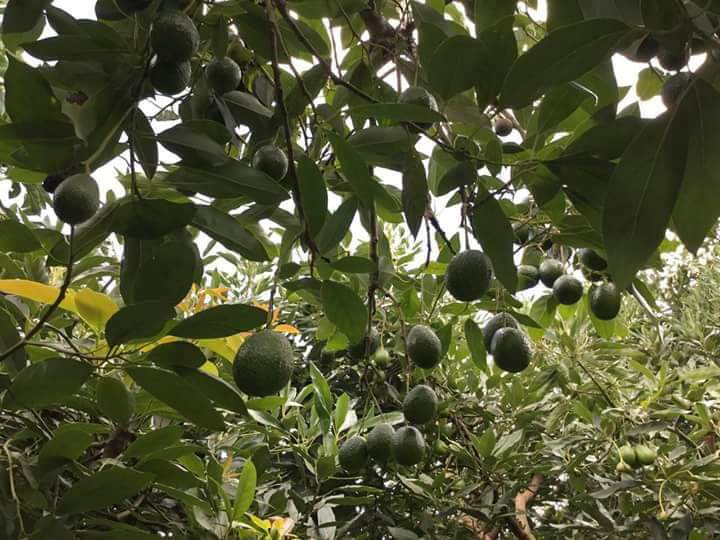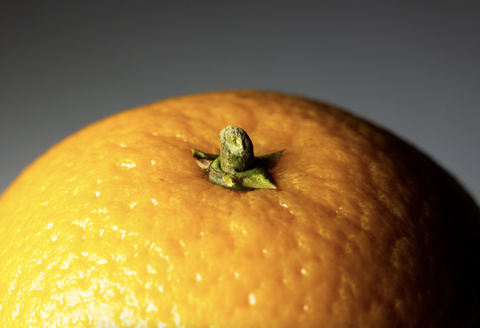Introduction
Tree tomato also known as Tamarillo is an egg-shaped edible fruit. The fruit contains high levels of fiber, vitamin A, B, C E and K and minerals, specifically iron, calcium, magnesium, potassium, phosphorous and is low in calories. It is an important source of pectin, carotene, and protein. Vitamin C, E and B-carotene (pro-vitamin A) are regarded as major nutritional antioxidants.
Utilization:
The tree tomato flesh can be added to stews to make unique flavor. Fruit can be eaten fresh, cooked, made into jam chutneys or blended with other fruit juices e.g. orange juice to make refreshing juice or added to vegetable salads. The yellow variety is preferred for processing. The fruits should not be cut on wooden or other permeable surface as the juice will make an indelible mark. The fruits are high in pectin and therefore have good properties for preserves. The unripe fruit contains high level of tannin, thus bitterness.
Potential for production
There is high demand for the fruit especially in the urban market in hotels, supermarkets, local markets and with food vendors. Consumers are increasingly becoming aware of the nutritional and medicinal properties of the fruit hence the current supply cannot meet the demand due to limited production at commercial level within the country. The fruit can be grown in a wide range of climatic zones, it requires minimal input and is easy to manage once established.
Varieties
The color of fruits varies from yellow and orange to red and almost purple. Sometimes they have dark, longitudinal stripes. Red fruits are more acidic, yellow and orange fruits are sweeter. Some varieties grown include: Ecuadorian orange, Gold mine, Inca gold, Red oratia , Rothamer giant, Ruby red, Solid Gold, Yellow. Grafting of all these varieties with an ensures faster maturity, drought resistance, more productivity and long life span. Grafted muthakwa tree tomato is a fast growing tree that grows up to 5 meters. Peak production is reached after 3-4 years, and life expectancy is about 12 years. They prefer subtropical climate. They grow in many parts of Kenya with rainfall between 15 and 20 degrees celcius.it is intolerant to frost (below -2 degrees Celsius) and drought stress. They grow naturally on soils with a PH of 5 to 8.5
Ecological Requirement
Altitude: The favorable production altitude in Kenya is 1000-2000m above sea level. However it can be grown up to 3000m above sea level. The fruit is slow to ripen in higher altitudes.
Rainfall: It requires rainfall 1200 – 2100 mm and cannot tolerate drought.
Soils: Tamarillos requires well drained fertile soils that are rich in organic matter. The tree does not tolerate water logging because of the shallow root system. Soil pH of 5-8.5 is suitable for production.
Temperatures: Tamarillos prefer warm conditions as long as the plants are also provided with sufficient moisture. Temperatures should be above 10°C throughout the year. Persistent heavy frosts can kill even well-established trees.
Planning for production
- Selection of suitable site with required condition
- Selection of species depending on market requirement
- Organizing for planting material from a registered nursery
Note: The area under production should be set aside and expanded gradually so that production is increased according to market demand.
Tree tomato can be grown in the open field and also in the green house.
Land Preparation
Land should be prepared to a fine tilth and manure incorporated into the soil. This reduces or eliminates the need to apply fertilizer. In poorly drained soils ridges prepare for planting.
Propagation
Seeds and cuttings may be used for propagation. Spacing of 5ft by 5ft should be observed. The size of the hole should be 2ft by 2ft. At least one bucket of manure (well decomposed) per hole which is mixed with the top soil and then put back to the hole leaving a small depression for watering.
Seeds
Seeds produce high-branched, erect tree. The tree does not always come true to type from seed, but is possible if seed is taken from red fruits with black seed pulp or yellow fruits with yellow seed pulp. Seed should be separated from pulp, washed and dried in the shade. Germination is accelerated by placing washed and dried seed in a freezer for 24 hours before planting out. Seeds- produce a high–branched erect tree ideal for sheltered locations; seeds germinate in 3-5 weeks.
Cuttings
Cuttings develop into a shorter, bushy plant with low–lying branches suitable for exposed windy sites. Cuttings should be from 1-2 years-old wood, 10-30 mm thick and 45-100 cm long.
Planting
The spacing in the field varies depending on the management practices, soil fertility and environmental conditions. The spacing is 2.5 -3 m apart between plants and 3 m between the row or 1.0-1.5m between plants and 4.5-5.0m between rows. Closer spacing is recommended in windy unprotected locations.
Manure and Fertilizer
A compound fertilizer such as NPK may be applied at planting time if necessary; however a good supply of compost is normally adequate. Application of fertilizer is done after every 90 days.NPK can be alternated with C.A,N
Wind break
The grafted Tree tomato has big and many fruits and thus need protection from wind because branches can easily break. Staking can be done to prevent swaying and to minimize root disturbance.
Pruning
The tree should be pruned back the first year after planting to a height of 0.9-1.2 m to encourage branching. Pruning helps to control fruit size, plant size and harvesting. If timed properly pruning can extend the total bearing period. Yearly pruning is therefore recommended to eliminate old branches that have already fruited because fruits are normally produced on new growth. Light pruning leads to medium sized while heavy pruning leads to large sized fruits. Basal shoots should be removed. In the green house pruning prevents excessive vegetative growth.
Weeding
Deep cultivation around the plants should also be avoided
Irrigation
The plant cannot tolerate prolonged drought and should have sufficient water during dry periods. Supplement irrigate during dry periods especially at peak growth. Mulching is very beneficial in conserving moisture and also suppressing weeds. Watering is done once per week. Drip irrigation is encouraged for easy water management. We provide special drips for tree tomatoes and other fruits.
Harvesting
Tree tomatoes are ready to harvest when they develop red or yellow color. The tree is a fast-growing, starts bearing fruits from 6-8 months after planting and bears fruits all year round. Fruiting should be discouraged at 6 month since this retards growth. Peak production is reached after 1 year and it continues for 5-6 years with good management. The economical life span of the tree is about 6-12 years.
Storage
At room temperature the fruit can be stored for about 1 week, but under controlled storage it lasts for more than 2 months. The fruits ripens over a period of 6-7 weeks depending on environmental conditions hence can be left on the tree without rotting as the grower organizes for better market.
Challenges
Lack of adequate clean planting material is a serious challenge in production. Propagation is by use of cuttings or seeds from the locally planted trees. This may lead to disease transfer if cuttings or seed are obtained from unhealthy plants. Care should be taken while sourcing for planting material.
Note: Planting material should be obtained from registered tree nurseries.
Advice to potential growers
This enterprise is growing with high prospects due to increased demand for the fruits. Market supply is low hence the price of fruits is very high. Growers can organize for collective production within an area to ensure consistence supply and production for the targeted market. Value addition through juice making is an added advantage in marketing. The relatively costs of orchard establishment is low, however it requires careful management to ensure high quality yield
DISEASE AND PEST CONTROL
The tree tomato is susceptible to a number of problems, which can be controlled with proper care. Fruit flies will attempt to lay eggs in the fruit. The tough skin offers protection, but this makes the fruit unattractive for marketing as fresh fruit. Other type of pests includes aphids, ants and red spider mites. These are easy to control with the best pesticides. Some of the pesticides include prosper, thunder, Twiga Ace, sumidhion. Spraying is done after every 21 days in hot climate as most of the pests are active during the hot areas .Alternation of the pesticides is advisable as most of the pest can become resistant. Thus each chemical should be sprayed twice and then alternated.
The principal disease is powdery mildew which may cause serious defoliation of leaves if not controlled. It is not hard to control powdery mildew and other fungal diseases like bright as any simple fungicides can control, fungal diseases are spread by the speed of the wind and thus early control of the diseases is recommended. Some of the fungicides include red copper, ransom, Othello (control leaf rust), zetanil, daconil. Spraying is done every 21 days. Alternation of the fungicides is encouraged.
GRAFTED TREE TOMATO
Grafted Tree tomato is a fast-growing tree that grows up to 2-5 meters. The tree usually forms a single upright trunk with lateral branches. We graft our tree with ‘muthakwa’ for several reasons.
- Resistant to Nematodes.
- Drought resistant.
- Fast maturing.
- Higher life span.
CLIMATE, SOIL REQUIREMENT & GROWTH
The tree tomato prefers subtropical climate, they grow in many parts of Kenya with rainfall between 600 and 4000 millimeters and annual temperatures between 15 and 25 °C. It is intolerant to frost (below -2 °C) and drought stress. Tree tomato plants grow best in light, deep, fertile soils, however, soils must be permeable since the plants are not tolerant to water-logging. They grow well on soils with a pH of 5 to 7.5.
REQUIEMENTS:
Land, Manure, Grafted seedlings, Irrigation system, Labour, Pest and Diseases control,
At a good spacing an acre can accommodate 1200 – 1800 plants.
- Require a recommended spacing measuring 6ft by 6ft, then dig dip holes measuring 2ft by 2ft this helps in roots penetration and also to be able to accommodate enough manure.
- Add a bucket of well rotten manure into per hole and mix well with top soil.
- Plant your grafted seedlings by first ensuring you have watered your soil well or plant during rainy season. Add mulching to every stem of your plants.
- In case of a dry season apply irrigation either drip irrigation or bucket irrigation.
- For those that need to grow organically read about organic farming here.
- For conventional farming apply NPK fertilizer after two weeks of planting this will ensure faster growth and root development.
- Protect you plant from pest and diseases from early stages by splaying at a good interval depending with the rate of infestation with pesticides and fungicides both protective and curing ones.
- During entire growth season apply CAN fertilizer three times.
- Splay your plants with foliar feed to ensure faster and stronger plants and also during flowering to boost more flowers and ensure they do not drop.
PEST AND DISEASES
Tree tomato is fairly resistant to most diseases and pests. However, the tree is prone to powdery mildew, which causes the leaves to fall off. Application of copper oxychloride (allowed in organic farming) can control the disease.
The main pests that attack the tree include the aphids, thrips, whiteflies and nematodes (grafted tree tomato to control nematodes).
We ensure we remove barriers that hinder successful tree tomato farming like enlightening our customers on.
- Soil testing.
- Type of manure to use.
- Organic Farming.
- Why and how to use drip system in your farm.
- How to control pest and diseases.
- Management of the farm.
- Field visit.
- Management of the farms.
We do visit farms in any part of Kenya to advice farmers on what’s suitable on their farms depending on their area, apart from tree tomato we grow other types of fruit trees like passion fruits, Hass avocado, Macadamia, Oranges, Apples etc. We also do manage the farms on behalf of our customers. We deliver seedlings and fruits in any part of the country. Contact us and be part of the community that believe money grows on trees.





